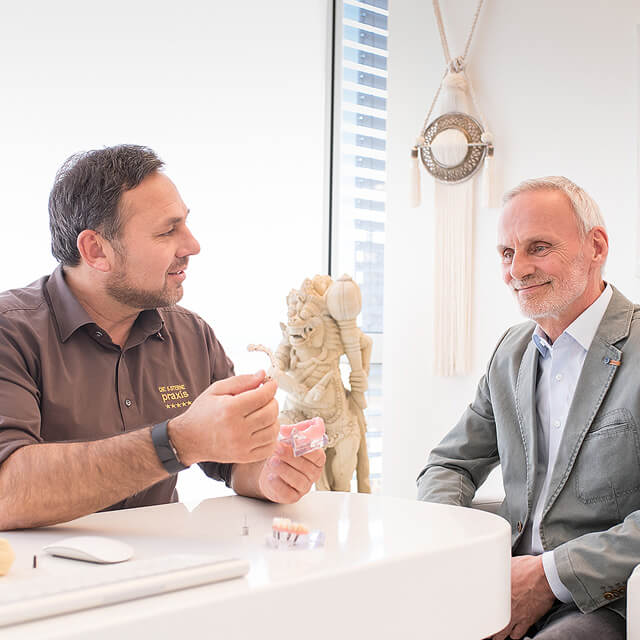FAQ Frequently Asked Patient Questions on Fixed Teeth in a Single Day
Dental Implants: The most Frequently Asked Questions and Answers
Provided a sufficient quantity of jaw bone is available, there is basically no reason not to have a dental implant. If periodontitis is present, which is an inflammation caused by bacteria and associated with recession of the gums, this should be treated first. If the amount of jaw bone is not sufficient, we can compensate for this with the help of modern bone grafting techniques.
Illnesses such as diabetes or severe general diseases (e.g. cardiovascular diseases or increased tendency to bleeding) do not exclude implanting artificial tooth roots either, however you must ensure you inform us about these.
There is only a minimum age in as far as the growth of bones should have been fully completed by the time the implant is inserted. In most cases this is achieved when patients reach adulthood at the age of 18. Whether this applies in individual cases can easily be determined by means of an X-ray of the carpus (wrist bones).
As the treatment is low-risk, in principle it can also be carried out without any problem at an advanced age. Accordingly, there is no maximum age limit.
If teeth, and consequently the natural chewing load in the jaw, have been missing for lengthy periods, the bone gradually recedes. This is similar to a muscle wasting away when it is not used. Certain germs can also destroy bones. In such cases we speak of periodontitis, better known as periodontosis – an inflammatory disease of the periodontium (or tooth bed). If the bone substance has been weakened to such an extent or is so thin that an implant can no longer find any purchase, then bone grafts are advisable. In this procedure, the bone tissue is restored as gently as possible using the patient’s own bone or bone replacement material. Often we use a mixture of both. The graft material is deposited directly onto the bones and is gradually converted by the body into resilient bone substance. In this way, the width or height of the bone can be increased. At the posterior maxilla (back of the upper jaw), the bone height is usually increased by the help of a so-called sinus lift by which we avoid part of the implant protruding into the maxillary sinus. Often it is possible to carry out the bone graft directly during insertion of the implant. However, a separate outpatient procedure may be required for this beforehand.
Yes. Implants have no electromagnetic effect which is why they do not affect pacemakers in any way.
Interactions may be possible with some types of medication. Cortisone and anticoagulant preparations, for example, have a large influence on the body. If you take medication regularly, you should definitely inform us of this. This is why we give you a patient questionnaire prior to treatment on which you can enter your information.
Implants are manufactured using titanium in most cases. Titanium is especially well-known from the field of earrings for its compatibility with the body. The metal is light and corrosion-resistant, as well as temperature-resistant. Thanks to its stability and longevity, it is used in many areas of medicine (e. g. in joint prostheses). The titanium oxide coating enables the solid growth of bones onto implants, and with this, the fixed integration of artificial implants into the human body. Rejection by the body and allergic reactions to titanium are very rare.
Furthermore, ceramics are well-known for use as implant materials due to their good biocompatibility.
Normally, bridges and crowns are manufactured from metal and covered with a ceramic material enabling the color of the crown to be matched to the color of the tooth. All-ceramic applications are also possible in which the replacement tooth is almost indistinguishable from the natural teeth.
With careful oral hygiene, the gums and the implant bed remain healthy and your implants can last an entire lifetime.
We cannot answer this question with a fixed amount, as costs are governed, amongst other things, by the type and number of implants, the dental prosthesis selected, and any preliminary treatments required. We should be happy to advise you in a personal consultation of the costs you can expect.
You can pay by instalments in our practice. We even offer this service interest-free for 12 months. Just ask us and we will be happy to discuss your individual payment plan.
Yes. Since January 2005 statutory health insurance companies in Germany have also been paying a fixed allowance for implant-supported restorations. This fixed allowance applies to ‘standard care’, which means a crown, bridge or prosthesis representing the minimum standard for a defined initial medical outcome.
If you can prove you had regular preventative dental check-ups over the last five years prior to the start of treatment, this fixed allowance increases by 20 per cent. If you can prove you had check-ups over the last ten years, the fixed allowance will increase by a total of 30 per cent.
If you find out in advance about the general circumstances regarding an implantation, you will be especially well equipped for the consultation. It may also be advisable to write your questions down in advance so that nothing remains unexplained. Apart from this, we likewise discuss possible general diseases or regular medication taken during the consultation appointment.
Treatment and the Period Following it
An implantation is a small operation. Through the opportunities for diagnosis and planning today, complications such as damage or injuries to nerves can largely be excluded. Accordingly, the risks are about as large as those for removing a wisdom tooth.
Even if sudden rejection reactions to fully-healed implants are very unlikely, they may still occur in very rare cases, with the bone not enclosing the implant firmly enough. As the implants cannot withstand sufficient stress in this case, they would probably need to be removed again – under local anesthesia – and if possible would need to be replaced.
This depends on your wishes. The procedure can take place either under local anesthesia or under general anesthesia. With patients who are anxious or where there is comprehensive treatment of both jaw bones, however, general anesthesia is advisable.
Mit dem LINK „SKY fast & fixed“-Konzept erhält der Patient neue, individuelle und feste Zähne an nur einem einzigen Zahnarzttermin.
Weitere Termine können für die Voruntersuchung, das Fädenziehen und die Nachkontrolle anfallen. Die Regeneration des Knochens erfolgt für gewöhnlich stressfrei ohne weitere Arzttermine.
With the ‘SKY fast & fixed’ concept the patient receives new, individual and stable teeth in a single visit to the dentist.
Further appointments may be necessary for preliminary examinations, removing stitches and follow-up checks. The regeneration of the bone usually takes place without any stress and without the need for further medical appointments.
Most patients can return to their everyday life again the day after their procedure and only rarely need to take painkillers. The cheek will probably still be a little swollen and the gums a little sensitive, but normally there will not be any further bleeding.
In consultation with your dental physician, usually you can return to your completely normal everyday lifestyle the day after the procedure and can return to work.
In order to aid the healing period, maybe you should rest for a few days. In principle, however, moderate movement will not present any problems.
Of course not. If you had a removable dental prosthesis beforehand, you can usually continue to use it in the interim. In other cases, we will provide you with a temporary prosthesis. There are high-quality alternatives to long-term ‘temporaries’, which can even be secured onto your implants, and only appear slightly different to your subsequent prosthesis and natural teeth.
Even though healing follows an individual path and we cannot give you exact details until after your diagnosis, we can decide in advance according to approximate guidelines: the period of healing in the lower jaw takes around 2 to 3 months while the upper jaw takes approximately 4 to 6 months on account of the low bone density.
As soon as the implants have grown securely into the bones, the permanent prosthesis can be fixed onto the implants. To do so, the upper part of the implant is exposed again and small caps are screwed into it temporarily so that the gums can develop properly. An impression is made of this, which the dental technician can use as a template for your prosthesis. As soon as the color has been matched and you are satisfied during the test fitting, the prosthesis can be secured for the long-term.
Life with Dental Implants
As soon as your permanent prosthesis has been secured in place, eating, biting and drinking will be possible without any problems. The prosthesis is so stable that you will feel comfortable and secure – just like with real teeth.
The prosthesis creates a completely normal feeling in your mouth so that you will not be able to feel any difference.
No. A prosthesis which is anchored to an implant is fixed securely in place. Normally you are able to wear them without any interruptions.
Smoking can endanger the long-term success of implants. For this reason, it is important that you inform us whether and how much you smoke during your consultation appointment so that we can better estimate your individual risk profile.
Cleaning is the secret to the long life of dental implants. You can clean your teeth without any complications using a toothbrush or electric toothbrush and toothpaste. The interdental gaps and the transitions to the gums are important when cleaning the teeth. You can prevent germs from settling which could attack the implant using dental floss or small interdental brushes. Professional tooth cleaning as well as special cleaning of the implant is advisable, too, and this should be carried out in the dental practice between two and four times annually, depending on the formation of dental tartar. With the correct oral hygiene implants can last your entire lifetime.
Inflammations which arise predominantly through bacteria can usually be successfully treated if they are detected early enough. Accordingly, it is important that you clean your teeth thoroughly and attend regular appointments for aftercare and prophylaxis.
The dental prosthesis can be replaced, changed or supplemented at any time. An implant for an individual tooth can also still be converted into an abutment for a prosthesis for a long time after treatment without any complications.
If one of the healthy teeth has to be removed, in general it can be replaced by a further implant without any problems. The surrounding parts of the prosthesis are then adjusted accordingly.
Dark teeth can often be brightened up using bleaching. Unattractive tooth fronts can be covered with plastic or fine ceramic shells (‘veneers’). The crowns for the implants are then designed with a brighter coating from the start or are adapted to the new tooth form. Ask us about this: there is a solution to almost every problem.
No, implants are not magnetic. They are very small and do not cause any reaction by airport detectors. In addition, you will have your implant pass with which you will be able to resolve the situation quickly and discretely, if necessary.



